FIFTH INTERNATIONAL
ORGAN AND
EARLY MUSIC FESTIVAL,
OAXACA, MEXICO
CONFERENCE ON THE THEME OF
“MUSIC IN THE CONVENTS OF MEXICO”
NOVEMBER 10 - 13, 2005
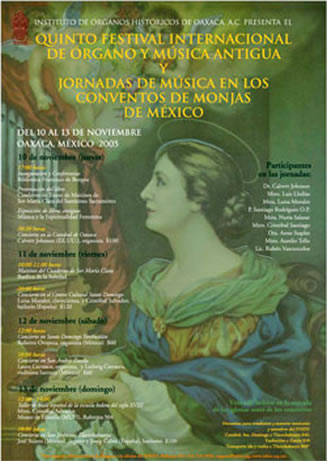
For the fifth consecutive year, the IOHIO was honored to present its annual organ and early music festival, so that music lovers from all over the world could once again hear the sound of Oaxaca´s baroque pipe organs. Besides the four organ concerts scheduled in the Oaxaca Cathedral, Zautla, Yanhuitlán, and Tlacochahuaya, this year´s festival also included a harpsichord and dance concert of Spanish music, a workshop of Spanish traditional dance, and visits to two unrestored organs in Santa María Tinú and Santa María Tiltepec.
In addition, a conference was organized in conjunction with the festival on the theme of “Music in the Convents of Colonial Mexico.” The impulse for this conference was the publication of a manuscript from the Archives of the Oaxaca Cathedral, “Cuaderno de Tonos de Maitines de Sor Ma. Clara del Santísimo Sacramento” (“Notebook of Psalm Tones for Matins of Sister María Clara of the Most Sacred Sacrament”), which was presented during the conference. This notebook consists of 58 pages of organ music compiled by a nun in the late-18th or early-19th century (composer(s) unknown) and opens a window to the world of convents and their music in colonial Mexico (New Spain), with which many of us may be as yet unfamiliar. The conference included lectures by musicologists and related specialists, visits to former convents, and performances of some of the pieces from the Sor María Clara notebook. The combination of the conference and festival activities offered an extremely full and culturally rich three-and-a-half day experience.

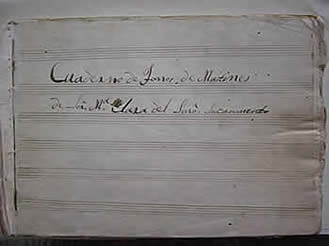
November 10 Participants gathered in the elegant space of the Francisco de Burgoa Library in the Santo Domingo Cultural Center for the Inauguration of the Fifth IOHIO Festival, the book presentation of Cuaderno de Tonos de Maitines de Sor María Clara del Santísimo Sacramento (Notebook of Psalm tones for Matins of Sister María Clara of the Most Blessed Sacrament) (Wayne Leupold Editions) and the first lectures on the theme of Music in the Convents of Mexico. Alfredo Harp Helú, patron of the IOHIO, expressed his support and enthusiasm for the project and padre Jesús Gopar, Vicar General of the Diocese of Oaxaca – in the name of the Archbishop of Oaxaca, Monseñor José Luis Chávez Botello – gave his blessing to the event.
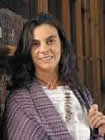 A special exhibit “Music and Feminine Spirituality” was organized in collaboration with our event by the director of the Francisco de Burgoa Library, María Isabel Grañen Porrúa. This exhibit brought together the most outstanding archive treasures in Oaxaca related to the theme of nuns and music in the convents, including the Sor María Clara notebook, the Gaspar Fernandez Songbook, Luz y Norte of Lucas Ruiz de Ribayaz, various documents relating to the subject of nuns, and some of the earliest published religious documents in Oaxaca. A special exhibit “Music and Feminine Spirituality” was organized in collaboration with our event by the director of the Francisco de Burgoa Library, María Isabel Grañen Porrúa. This exhibit brought together the most outstanding archive treasures in Oaxaca related to the theme of nuns and music in the convents, including the Sor María Clara notebook, the Gaspar Fernandez Songbook, Luz y Norte of Lucas Ruiz de Ribayaz, various documents relating to the subject of nuns, and some of the earliest published religious documents in Oaxaca.
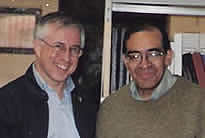
The first lecture was by musicologist Aurelio Tello (Centro Nacional de Investigación, Documentación e Investigación Musical CENIDIM, México D.F.), who presented an overview of the musical culture of nuns in colonial Mexico. Tello has transcribed numerous music manuscripts from Mexican and Latin American archives and was a principal collaborator in the publication of the Sor María Clara notebook.
He was followed by art historian Nuria Salazar (Universidad Iberoamericana y Departamento de Monumentos Históricos del INAH), who spoke about the nuns and their music in the convent of Jesús María of the Immaculate Conception in Mexico City.
 The title of the talk by IOHIO archive researcher Ricardo Rodys was originally “Recent research in the archives of the Oaxaca Catedral,” but in reality he spoke about “Who was Sor María Clara del Santísimo Sacramento”? Just weeks before the conference, he discovered an extremely important document in the Notarial Archive—Sor María Clara´s will when she entered the Conceptionist convent in 1835 (and had to give up all her earthly possessions). From there, he was able to trace her genealogy and prove that she was Oaxacan and an organist, even though it is still unknown whether she composed any of the pieces in her notebook or she simply compiled them. The title of the talk by IOHIO archive researcher Ricardo Rodys was originally “Recent research in the archives of the Oaxaca Catedral,” but in reality he spoke about “Who was Sor María Clara del Santísimo Sacramento”? Just weeks before the conference, he discovered an extremely important document in the Notarial Archive—Sor María Clara´s will when she entered the Conceptionist convent in 1835 (and had to give up all her earthly possessions). From there, he was able to trace her genealogy and prove that she was Oaxacan and an organist, even though it is still unknown whether she composed any of the pieces in her notebook or she simply compiled them.
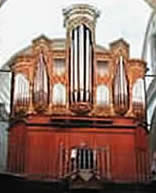
We then walked from Santo Domingo to the Oaxaca Cathedral for the First Concert of the Festival offered by organists Calvert Johnson (chair of the music department, Agnes Scott College, Georgia). His eclectic program included several pieces by women composers, one of his areas of specialization, and some from the Sor María Clara notebook, as well as other works representing a wide range of national and chronological styles, even including a samba!
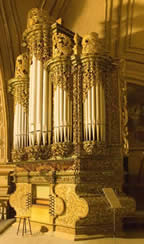
November 11 That morning we gathered in the Basílica de la Soledad for an orientation offered by Calvert Johnson about liturgical music in general and the versets from the Sor María Clara notebook in particular. Participants sang the chants in alternation with Johnson playing the versets on the organ.
We then met up with our guide Rubén Vasconcelos Beltrán, the official historian of the city of Oaxaca. First he gave us a tour of the former convent of San José (Carmelitas), located just in front of la Soledad, which now serves as the Escuela de Bellas Artes (arts school), and then we returned to la Soledad (Agustinians), where the spacious former convent now serves as the Oaxaca City Hall.
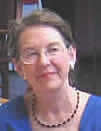
The morning´s activities were concluded with a fascinating talk by historian Anne Staples
(Colegio de México) in the Presidents´ Room of the city hall. The theme of her lecture was “The Daily Life of Nuns in Colonial Mexico.” During her presentation we even heard about such topics as: which convents allowed the nuns to drink chocolate and which not, and if a drink of chocolate meant that you were breaking a fast.

The afternoon session began with Calvert Johnson, editor of the publication of the Sor María Clara notebook, speaking about musical interpretation and performance practice. Johnson is an expert on such themes and has edited several books in collaboration with Wayne Leupold Editions on the historic repertoire of various European countries during particular historical time frames. (To read Calvert Johnson´s report of the Fifth Festival, click here).
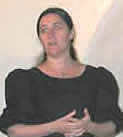 Next Luisa Morales (founder and director of the Festival Internacional de Música para Tecla Española, FIMTE, or International Festival of Spanish Keyboard Music) spoke about her ongoing research in the convent of San Pedro de las Dueñas, León, Castilla. Several years ago, she discovered boxes full of 18th keyboard scores and since then has been transcribing and performing the music. Many manuscripts are copies of known works by Scarlatti and Soler, but others are original. She also discovered several antique undocumented harpsichords in the convent. Next Luisa Morales (founder and director of the Festival Internacional de Música para Tecla Española, FIMTE, or International Festival of Spanish Keyboard Music) spoke about her ongoing research in the convent of San Pedro de las Dueñas, León, Castilla. Several years ago, she discovered boxes full of 18th keyboard scores and since then has been transcribing and performing the music. Many manuscripts are copies of known works by Scarlatti and Soler, but others are original. She also discovered several antique undocumented harpsichords in the convent.
The third lecture of the afternoon was by Luis Lledías (Mexican doctoral student in musicology at the University of Valladolid, Spain) on “The Musical Education of Girls in Private Schools in Mexico City during the Colonial Era.” Lledías has put several of these historic methods into practice by training a group of young musicians to sing and play instruments according to the methods described in manuscripts.
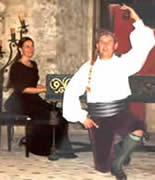 Alter the conferences, we proceeded directly to the cloister of the former convent of Santo Domingo to hear the Second Concert of the Festival presented by Spanish harpsichordist Luisa Morales and bolero dancer Cristóbal Salvador. The first part of the program consisted of harpsichord works by the 18th century composers Domenico Scarlatti and padre Antonio Soler, including a fandango discovered among the manuscripts in the convent of San Pedro de las Dueñas. In the second part of the program, Cristóbal Salvador performed 18th century Spanish bolero dances accompanied by harpsichord sonatas. Similar to anthropologists or musicologists from a bygone era, Salvador has been researching and documenting dances in villages in the south of Spain, which now are only known by the elderly and in danger of disappearing. He and Morales discovered that the dances coincided exactly in phrasing, meter, and structure to the harpsichord sonatas of the same period, indicating that the composers were familiar with the dance tradition and had their rhythms and images in their minds as they composed. Alter the conferences, we proceeded directly to the cloister of the former convent of Santo Domingo to hear the Second Concert of the Festival presented by Spanish harpsichordist Luisa Morales and bolero dancer Cristóbal Salvador. The first part of the program consisted of harpsichord works by the 18th century composers Domenico Scarlatti and padre Antonio Soler, including a fandango discovered among the manuscripts in the convent of San Pedro de las Dueñas. In the second part of the program, Cristóbal Salvador performed 18th century Spanish bolero dances accompanied by harpsichord sonatas. Similar to anthropologists or musicologists from a bygone era, Salvador has been researching and documenting dances in villages in the south of Spain, which now are only known by the elderly and in danger of disappearing. He and Morales discovered that the dances coincided exactly in phrasing, meter, and structure to the harpsichord sonatas of the same period, indicating that the composers were familiar with the dance tradition and had their rhythms and images in their minds as they composed.
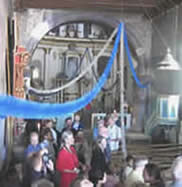 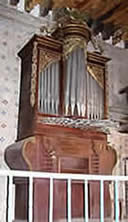 November 12 Our traditional all day field trip to the Mixteca Alta began with a visit to the church of Santa María Tinú. This charming stone church of modest dimensions houses an organ disproportionately large for the interior space. The organ is intact, seems to date from the early 19th century, and still groans and wheezes when the keys are depressed and the bellows raised. It is possible that a good clearing and repair of the wind leaks could restore it to playable condition, without engaging in a more intrusive intervention. November 12 Our traditional all day field trip to the Mixteca Alta began with a visit to the church of Santa María Tinú. This charming stone church of modest dimensions houses an organ disproportionately large for the interior space. The organ is intact, seems to date from the early 19th century, and still groans and wheezes when the keys are depressed and the bellows raised. It is possible that a good clearing and repair of the wind leaks could restore it to playable condition, without engaging in a more intrusive intervention.
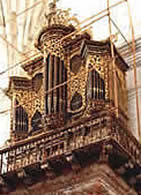
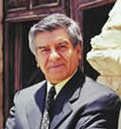
Our next stop was in the Dominican church and former convent of Santo Domingo Yanhuitlán for the Third Concert of the Festival. The program offered by Mexican organist Roberto Oropeza (organ professor in the Mexico City Conservatory) consisted of works by Spanish, Italian, and English composers from the 16th to 18th centuries. It was a rare treat to hear this organ, which is frequently inaccessible.
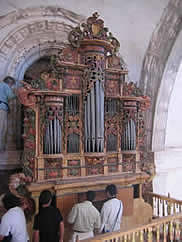
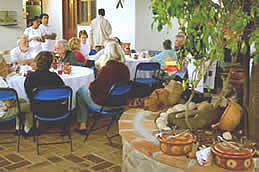
From here we proceeded to Santa María Tiltepec. This is a traditional stop during our festivals, because the 17th century church and the 18th century organ are so extraordinary. The custodian of the church, Don Arnulfo Cruz, and his family offered us a midday dinner at their home by the river and demonstrated the traditional way of barbecueing sheep, cooked in a hole in the ground with hot rocks and herbs.

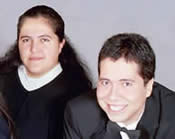 The Fourth Concert of the Festival took place in San Andrés Zautla and the audience included lots of people from the community. The sister and brother duo Laura y Ludwig Carrasco (both graduate students at the Eastman School of Music, New York), performed a program based on manuscripts from Mexican archives, which included pieces from the Sor María Clara notebook as well as a series of transcribed 18th century sonatas from the Mexico City Cathedral. The Fourth Concert of the Festival took place in San Andrés Zautla and the audience included lots of people from the community. The sister and brother duo Laura y Ludwig Carrasco (both graduate students at the Eastman School of Music, New York), performed a program based on manuscripts from Mexican archives, which included pieces from the Sor María Clara notebook as well as a series of transcribed 18th century sonatas from the Mexico City Cathedral.
November 13 Our guide Rubén Vasconcelos Beltrán took us through the former 16th century Dominican convent of Santa Catarina de Siena, which was transformed during the 1970s into a hotel (presently the Hotel Camino Real).
Afterward, approximately 30 dance students gathered in the lovely garden of the Oaxaca Philatelic Museum for a workshop of 18th century Spanish bolero dance offered by Cristóbal Salvador. The music with its slight Arabic influence, the clicking of the castanets, Cristobal´s jokes, and everyone´s good spirits made the observers wish they were younger and more agile so that they too could dance with the group.
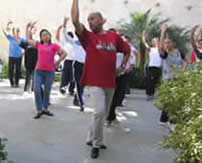  
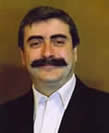 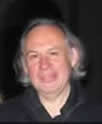 The Festival came to a magnificent conclusion in the church of Tlacochahuaya. Josep Cabré, renowned Spanish tenor, and José Suárez, esteemed Mexican interpreter of historic organ repertoire, offered a splendid concert of Spanish and Italian sacred music. The musical balance and the acoustics within the space of the church were so amazing that it seemed as if these artists were playing the church itself like a musical instrument. The Festival came to a magnificent conclusion in the church of Tlacochahuaya. Josep Cabré, renowned Spanish tenor, and José Suárez, esteemed Mexican interpreter of historic organ repertoire, offered a splendid concert of Spanish and Italian sacred music. The musical balance and the acoustics within the space of the church were so amazing that it seemed as if these artists were playing the church itself like a musical instrument.
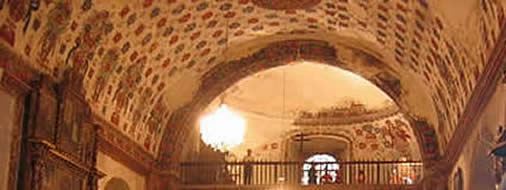
As usual, the Festival attracted an extremely interesting group of people from Mexico and abroad—musicologists, colonial art historians, a curator from the Louvre, organists, organbuilders, organ students, writers, sacred music experts—and generated an atmosphere of good will and camaraderie as well as the desire to keep in touch with new friends. A contact list was distributed and new projects—publications, concerts, and research opportunities—are already being discussed. It was a most gratifying experience for the IOHIO and we hope that this marvelous Festival will have some impact on the panorama of historic organs and early music.
The IOHIO is grateful for the support of the following institutions:
Instituto Nacional de Bellas Artes (INBA)
Instituto Nacional de Antropología e Historia (INAH)
Arquidiócesis de Antequera Oaxaca
Municipio de Oaxaca de Juárez
Secretaría de Cultura del Estado de Oaxaca
Fundación Alfredo Harp Helú Oaxaca A.C.
Biblioteca Francisco de Burgoa
Centro Cultural Santo Domingo
Embajada de España en México
Universidad de Valladolid, España
Agencia Española de Cooperación Internacional
Caminos y Puentes Federales (CAPUFE)
We are also grateful for the support of the following Oaxacan businesses:
Hotel Anturios
Hotel Casa Arnel
Hotel Casa Cue
Hotel Gala
Hotel Marques del Valle
Hotel Parador San Agustín
Hostal de la Noria
Proveedora Gráfica de Oaxaca
|

